#lace pelerine
Photo

La Mode, Pl. 372, 3 mai 1834, Paris. Chapeau en gros de France orne de fleurs. Robes de taffetas écossais broche. Pelerine de mousseline brodée. Digital Collections of the Los Angeles Public Library
The woman on the left is wearing a gray dress with green stripes, floral print, a white tippet, and a ceinture (belt) around her waist. She is wearing white gloves and is holding a parasol in her left hand. She is wearing a green bonnet decorated with flowers and bows. The seated woman on the right is wearing a yellow dress with gigot sleeves, a white tippet, and a ceinture (sash) around her waist. She is wearing white gloves and a blue bonnet decorated with bows and flowers.
#La Mode#19th century#1800s#1830s#1834#periodical#fashion#fashion plate#color#description#lapl#dress#gigot#plaid#pelerine#lace
45 notes
·
View notes
Text




Girl's dress with pelerine and removable sleeves.
England, circa 1869
Silk plain weave, printed, with silk lace
From LACMA collection
#child fashion#1860s#19th century#19th century fashion#lace#pelerine#my post#19th century extant garments
3 notes
·
View notes
Text
So weird to me that crocheting makes my left hand cramp faster even tho I'm gripping a piece of metal in my right hand
#jays stitch bitch corner#im trying my hand at crochet after 9 years#making a period accurate pelerine#but god damn its so much slower than knitting#cant take my eyes off for even a momebt#impossible to read or watch anything the way i do when im knitting#this blog is a knitting truther btw crochet bitches come argue#knitting my ride or die actually#until like tatting and cross stitch enter the chat then im like go fuck yourself im gonna make pretty lace
1 note
·
View note
Text


'silk wedding dress, over-sleeves + pelerine trimmed with blond silk lace, british, 1828' in the wedding dress: 300 years of bridal fashions - edwina ehrman (2011)
588 notes
·
View notes
Text
Extremely similar fashion plates from 1861 and 1862




I just wanted to share easily the coolest two fashion plates in my collection. They’re both part of the small collection that I inherited from my grandmother and I have no idea where they came from, other than that like most of the fashion history recourses I got from her they’re probably from when she studied sewing in the 1960s.
They’re two fashion plates with descriptions from one November 1861 and the other from April 1862, from the Englishwoman’s domestic magazine.
The first thing about them is that they are incredibly similar looking, similar clothing, similar colours, the same amount of figures including a child. It was probably a deliberate choice to have two very similar plates to better showcase the similarities and differences between the two years and spring and autumn fashion.
The other cool thing is that they are both mounted on paperboard and have descriptions of each one mounted on the back seemingly clipped from the original magazines (though the could be the place my grandmother got it from). I’ve transcribed the descriptions under the cut.
November 1861
DESCRIPTION OF THE COLOURED PLATE.
1st figure on the left side: The bonnet is composed of white satin, trimmed with black velvet and black and white blonde, and a bunch of flowers on each side. The mantle, which is made in a shawl shape, is composed of velvet, and trimmed with black guipure. The top of the mantle is finished off by a guipure pelerine, which is fastened behind and on the shoulders on by a handsome gimp rosettes with tassels. The large sleeve which comes to a point at the bottom, is pleated at the top of the arm under the gimp rosette and tassel. The dress consists of one of the fashionable broché silks.
2nd figure: The turned up hat is ornamented with a kind of fur trimming and long drooping feather. The paletôt fits tightly to the figure, and may be made of velvet or a thick cloth. It is trimmed with fur, and is made open in the front with revers, the sleeves being large and also trimmed with fur. Two little pockets ornament the front of the paletôt, which are also finished off by a band of fur. There are three fancy gimp buttons on each side of the body, and the waist behind is also ornamented in the same manner with two gimp buttons. The dress may be made in silk or poplin.
Little girls dress: The little Tudor hat is trimmed with blue velvet and a blue feather tipped with white. The pardessus is made to fit the figure; it is trimmed with fur, and is made with a fur pelerine or cape. The dress, which is striped, is bound at the bottom with a piece of black velvet.
3rd figure: The bonnet is composed of velvet, and ornamented with a bunch of flowers on the top, feathers on either side. The cloak is made of a shoulder piece, into which the fullness is pleated; the sleeves are large, and the garment is trimmed with fur, whilst the pelerine is composed of this material. This cloak may also be made in velvet, and trimmed with chinchilla, or corded silk, trimmed with velvet, and with velvet pelerine. These cloaks are usually made so that they may be worn with or without the fur cape, according to the weather; and in this style are excessively convenient for the changeable English climate.
4th figure: The velvet bonnet is ornamented with bands of satin cut on the cross-way, and roses and lace. The long jacket is made tightly fitting to the figure, in thick corded silk and is trimmed with gimp. The back of the skirt is cut to form three large pleats behind, each of which is ornamented with handsome gimp rosette and tassels. Bright blue poplin dress, made with quite a plain skirt.
April 1862
DESCRIPTION OF THE COLOURED PLATE
1st figure on the left: The bonnet is made with drawn front violet silk, and the soft crown of embroidered white tulle. The curtain is of violet sills, edged with a puffing of tulle; the strings are of broad white ribbon, and the bandeau consists of one large rose, ornamented on each side with bunches of wheatears. The pardessus is made of unlined corded silk, with a deep cape , and is trimmed with narrow Maltese lace and two two rows of narrow black velvet. The garment is cut in slightly to the figure behind, but is straight in front. The sleeves are of deep bell shape, trimmed round the bottom with a pleating of silk. The dress is violet silk, brocaded with black, the colour of the dress exactly matching that of the bonnet.
2nd figure:
The bonnet is of white crêpe, ornamented quite at the top with a large bunch of white ostrich feathers, and the Bandeau Impératrice is composed of one rose with leaves on each side. This mantle, which is quite circular, is made of plain glacé silk, trimmed with a broad gimp, whilst the neck is ornamented with a row of gimp, finished off with a tassel fringe. The dress is of drab silk, made with one flounce at the bottom, headed by two bands of silk of the same colour.
3rd figure: -Summer Costume.- This elegant costume, which is a charming toilet for a picnic, is composed of white muslin. The dress is made with a series of narrow flounces, all edged with narrow green ribbon. The burnous, also of white muslin, is trimmed with green silk ruching, and three handsome green tassels. The hat is composed of green silk, trimmed with a full plume of white feathers. This costume may be made more useful and durable by substituting white barège for the muslin, but in all cases (to look nicely) the cloak should be composed of the same material as the dress. White grenadine or lama might be used with advantage in this toilet, and the colour of the trimmings and hat might be altered to pink or light blue, suiting the colour to the complexion of the wearer.
4th figure: -seaside costume- The Leghorn hat is bound on the upper part of the brim with black velvet, and is trimmed with a white ostrich feather. The dress and jacket illustrated in this figure are both made of the same material, either nankeen, buff piqué, or Victoria cord, the latter material being rather thinner than pique. The coat is ornamented with a braiding design in black, the pocket, revers, and cuffs being trimmed to correspond. A costume of white piqué, braided in balance, would be equally stylish.
5th figure: -little girls costume- The straw hat is bound with violet velvet, and is trimmed with two white feathers, one lying on each side of the hat. The cloak is composed of silk, and is made with three single pleats behind, attached to a neck-piece, the front being perfectly plain. No trimming whatever is required for this stylish little garment with the exception of two rows of piping round the neck-piece. Black silk is, of course, the most appropriate material for a child's mantle; our illustration is coloured violet, to add to the effect of the picture, which would have been somewhat sombre were all the figures shown with black mantles.
Full-sized paper patterns, cut out in tissue paper, tacked together and trimmed, of all the mantles illustrated in this plate, may be had of Madame Adolphe Goubaud, 248, Strand, London, W.C., at the following prices:.
#Fashion history#historical costume#historical fashion#historical costuming#fashion plates#1860s fashion#1860s dress#dress history#fashion plate#1860s#victorian era#19th century#19th century fashion#victorian dress#edited one of the photos for a better quality one
35 notes
·
View notes
Text
Fashions of the Early 1830s: Large Hats and Leg-o-Mutton Sleeves
I was obsessed with Victorian era fashion for way too long! Let's jump back a few years and take a look at what royals and high-society women were wearing from 1830 to about 1836.

Vincente López Portaña (Spanish, 1772–1850) • Maria Cristina de Bourbon, Queen of Spain (fourth wife of Fernando VII) • 1830 • Museo Nacional del Prado, Madrid
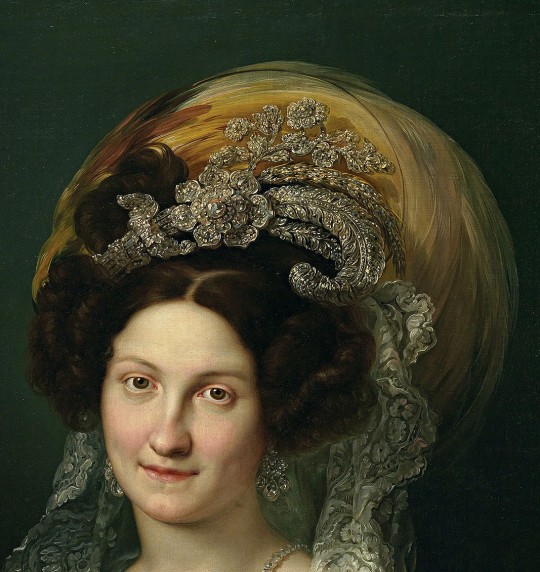

The style of the blue gown above is in keeping with Romantic era fashion, with its elbow-length puff sleeves with lace trim and pleated bodice. For formal attire, long gloves were worn.
The Maria Cristina de Bourbon portrait is of a royal subject, therefore the jewel-studded headpiece is especially grand, as is the bodice ornament and earrings. The feather was characteristic of the times – very large hats with feathers were in vogue, as well as large bonnets. The Spanish queen is wearing a lace mantila with her headpiece, which I assume is a symbol of her Spanish heritage.
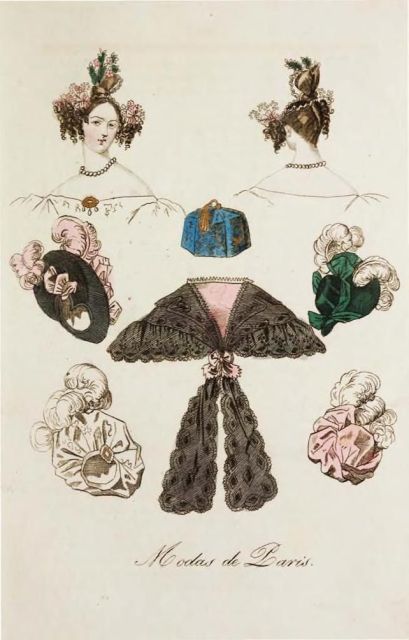
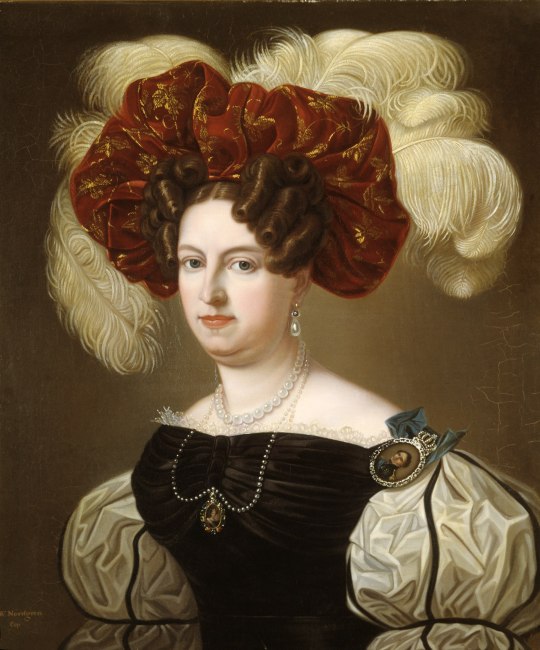
The fabric of the queen's dress is extraordinarily elaborate, with all-over silver thread embroidery. The bodice on this and many early to mid 1830s dresses was called a bodice à la Sevigne, which was made up of a central boned band divided into horizontal folds of fabric.
Belts and wide ribbons around the waist were often featured on dresses of the early to mid 1830s.
The fashion from circa 1830 to 1835 was one of over-porportioned extravagance. Sleeves larger than were ever seen or since been, width at the shoulders, and dramatic hats and headpieces.
Hair too was over-the-top. Notice the perponderance of elaborate braids, coils, and curls in these images.

1830-34 • British • Printed Cotton Day Dress • Victoria and Albert Museum
One such dramatic feature of 1830s fashion was the pelerine, a lace covering that was worn over the shoulders. The cut of the neckline was already exagerated to emphasize width at the shoulders; adding a pelerine only added to that width as well further acting as more ornamentation to the outfit.
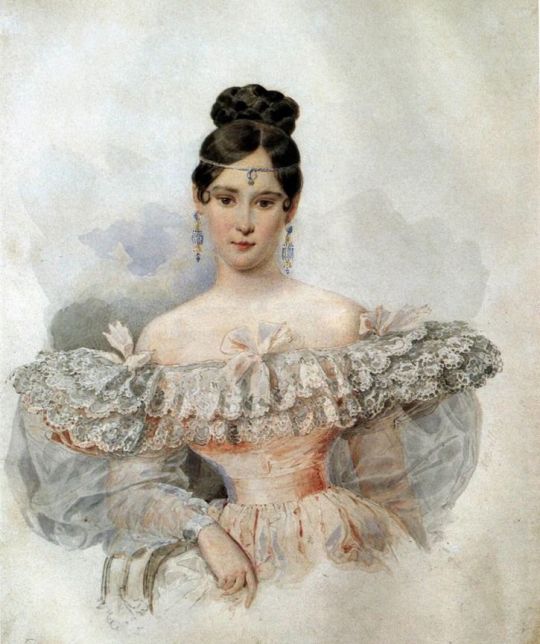
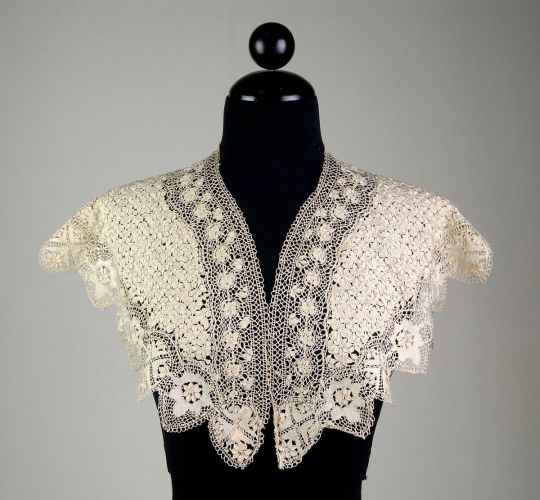
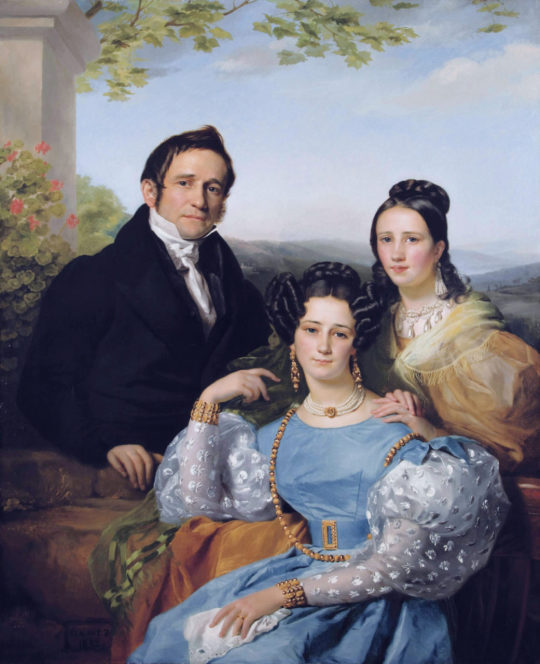
François-Joseph Navez (Belgian, 1787-1869) • Théodore Joseph Jonet and his two daughters • 1832 • Private collection
Sleeve style quickly evolved from simply puffy to Gigot or leg-o-mutton sleeves – a huge, billowy sheer sleeve over a smaller one, continuing with a tight-fitting long sleeve.
This flamboyance in sleeves was to suddenly come to an end around 1836. More about that in a future post, as I continue to flit willy-nilly along the fashion history timeline!
References:
• Fashion History Timeline: 1830-1839
• Wikipedia: 1830s in Western Fashion
• Wikipedia: Pelerene
• Mimi Mathews: The 1830s in Fashionable Gowns: A Visual Guide to the Decade
#art#portrait#painting#fashion history#royal portraits#fine art#art history#romanticism and fashion#1830s fashion#historical fashion#art & fashion#family group#the resplendent outfit blog#art & fashion blog
30 notes
·
View notes
Text
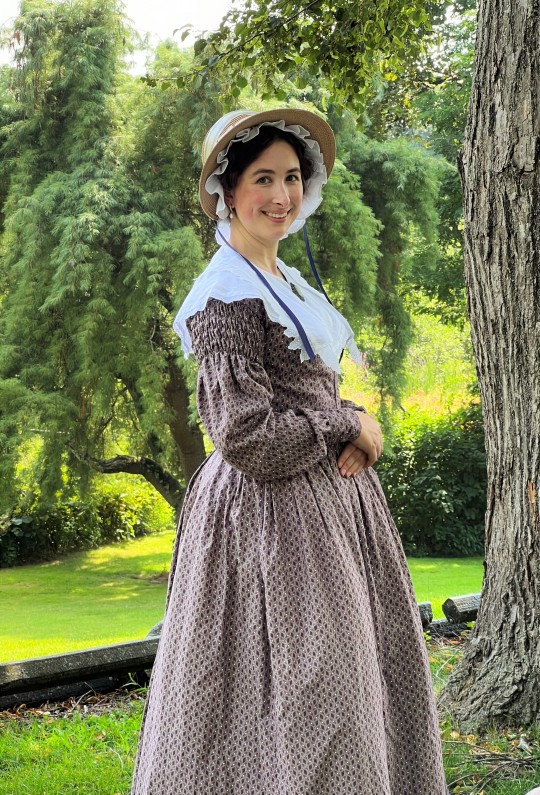

The 1830's dress!
pattern is a modified combination of two dresses in Patterns of Fashion 1 from around 1837. It is a higher-collared morning dress in a reproduction cotton, with tightly-gathered upper sleeves and a full skirt. The bodice is lined with polished cotton and closes center front.
Worn over a gored-bust corset and starched petticoats, including a corded one! Pelerine is a light cotton/linen blend trimmed with lace and closed with a reproduction cameo brooch.
#1830s dress#early victorian#historical dress#historical sewing#historical costuming#i am pretty pleased with how it turned out#ringwood manor#i made this
8 notes
·
View notes
Text
Friday 10 January 1840
10 10/..
2 20/..
fine morning R9 ½° at my bedhead, and R9° on the console at 11 a.m. breakfast at 11 ½ a.m. to 12 ¼ - out at 12 40/.. left my London [lace] pelerine at Madame Ocouloffs’ for her to copy the pattern and then left our cards for the baronne Rosen (ill – confined to her bed since yesterday) – then left our cards for the princess Michel Galitzin who was driving off from the door as we drove up – in returning went to Baileys’ the German coach maker on the Tverskoi [Tverskoj] boulevard – the Englishman had left him not long ago – alighted – saw his carriages – all for town-use, nothing in my way – home at 1 40/.. – told George to look about for a little 2nd hand calêche not high priced – he asked if the carriage was to come in the evening – come in the evening was it not always here – no! not now, and it came out that now Mrs. Howard will not have the horses in the stable or standing in the court!!! walked about the rooms – had Mrs. Fischer about ½ hour till very near 3 – dressed in a white gros de Naples evening gown with net ficher, and lilac silk shawl mantilla and white silk hat and green ribands – told us of the great incendie of the fabrique of Alexandroosky – 6,000,000/. (of roubles loss) – the emperor there 36 hours – not yet in the gazette because always wait for an official account – wrote the first few lines of today when at 3 10/.. the princess Arblinsky and her oldest daughter called and sat 25 minutes – very nice good comme-il-faut personne – had heard the loss estimated at much more than 6,000,000/. but did not say how much more – and would not have mentioned the incendie at all if I had not mentioned it – princess R- must have heard of it – ½ Moscow must have heard of it – but nobody ever mentions anything?
R -15° at 8 a.m. out of doors
this a very extraordinary year – never cold like this – seldom more than 10° of cold, or if they have it is for 3 or 4 days, and then over – but now no roads, no anything – disette – terrible for the people – the balls at the great assembly rooms so ill attended because the society of Madame Apraxin the haute society not enough to fill those large rooms – il faut de toute les sociétés – all ranks and 2/3 of the 2nd society (2nd set) not come to town this winter, but remaining in the country -
It seems .: that les bals nobles here are as much mixed as balls anywhere else – such in fact must be the case – Mrs. Fischer had heard of the incendie from a Mr. -------- somebody come with a French expedition littèraire that has been in Finland etc. come from St. Petersburg, and going to Sweden and Denmark Mr. F- thought but did not seem very clear – is she now little besides herself? the artist with these expedition wishes to take Mr. Fischers’ portrait – a likeness taken and engraved about 2 years ago, the best – asked if F- had not given it to me – had just written so far now at 4 10/.. – then and after dinner till after one at night writing copy of letter to Vere – dinner at 6in about ¾ hour – tea at 8 – had Grotza at 12 – very fine day – R9 ¾° on the console and 10 ¼° on my table – Madame O- sent back the pelerine this afternoon – before dinner
2 notes
·
View notes
Photo

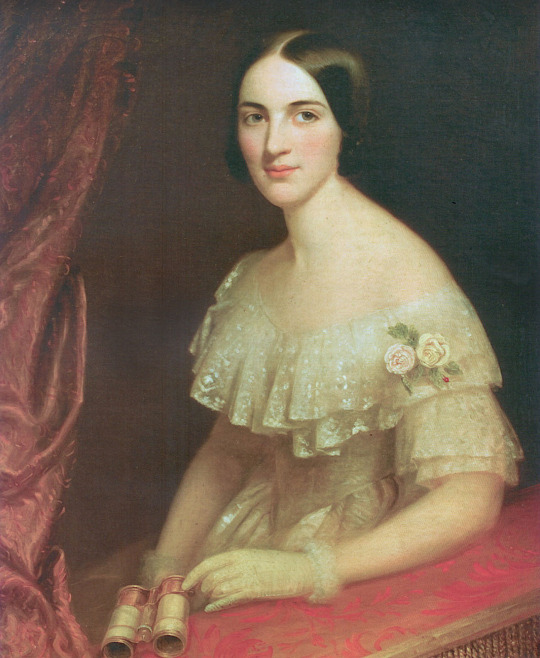

Ekaterina Goncharova, Baroness Gekkern:
1838 Ekaterina Goncharova, Baroness Gekkern by Jean-Baptiste Sabatier (Alexander Pushkin Memorial Museum - St. Petersburg, St. Petersburg Federal City, Russia). From Wikimedia; removed spots and vertical cracks with Photoshop 1833X2048 @300 2.6Mp. This is an outstanding example of a pelerine.
1840 Ekaterina Goncharova by ? (State A. S. Pushkin Museum - Prechistenka Ulitsa, Moskva, Russia). From Wikimeida; darkened light patch in c. bkgnd with Photoshop & decreased temp' 85% and satn 10% and increased sharpness 100% 1307X1608 @200 429kj.
1840 Catherine Gontcharoff, baronne d'Anthès Heeckeren by Henri Beltz (location ?). From Wikimedia; expanded to fit screen 1848X2854 @144 794kp,
I hope this is the back story - Ekaterina Goncharova's story is interesting. According to her French Wikipedia article (Google translation), "She spent her childhood and teenage years in Moscow, where he received a good education.In the fall of 1834 at the invitation of his younger sister, Natalia, wife of Alexander Pushkin, Ekaterina moved to St. Petersburg with her in the house of Pushkin. In December of the same year she became a maid of honor to the Empress. (The Empress is Alexandra Feodorovna - gogm) Ekaterina met Georges-Charles d'Anthes in the fall of 1834, shortly after moving to St. Petersburg. Their wedding took place January 10, 1837, in two ceremonies: one Catholic and one Orthodox. The couple had four children.She died Oct. 15, 1843, due to puerperal fever after giving birth to her son."
According to his Wikipedia article, George Charles d'Anthes was an Alsatian aristocrat and military officer who supported the Bourbons and not the Orléanists in 1830 so he went back to Alsace and then was allowed to serve abroad. He ended up in St. Petersburg. There he joined the Knights Guards and also met and married Ekaterina.He also met the Dutch plenipotentiary to the court, Baron Heeckeren. Baron van Heeckeren was childless and did not want his title to become extinct. "After a lengthy correspondence and a journey to Alsace, the latter (Baron Heeckeren - gogm) proposed to d'Anthès's father to adopt the son as his heir. After the agreement of the King of the Netherlands, Georges-Charles d'Anthès took the name of Georges-Charles de Heeckeren d'Anthès."
"D'Anthès met Pushkin and his wife, Natalia ("Natasha"), a beautiful and flirtatious young woman who had many admirers. D'Anthès courted her in such a way that Pushkin threatened him. D'Anthès then married Natalia's own sister, Yekaterina Goncharova, on 10 January 1837. It has been suggested that d'Anthès's engagement and marriage to Natalia's sister was devised to contradict society gossip that he was in pursuit of Natalia. In any event, this was not enough to soothe the conflict between the two new brothers-in-law, especially since an anonymous letter nominated Pushkin Deputy Grand Master and Historiograph of the Order of Cuckolds. Pushkin's jealousy made him write an insulting letter to d'Anthès's adoptive father. Pushkin having refused to withdraw these abuses, a duel became inevitable." Baron d'Anthes fired first, fatally wounding Pushkin.
#1838#1830s#1840#1840s#early Victorian#Jean-Baptiste Sabatier#Henri Beltz#straight hair#side braid coiffure#lace pelerine#pleated bertha#elbow length close sleeves#flared cuffs#long sheer over-sleeves#V waistline#full skirt#lace bertha#lace cuffs#off-shoulder nee waistline#off-shoulder straight neckline#Baroness Gekkern
1 note
·
View note
Photo

Lace pelerine, 1600s.
25 notes
·
View notes
Photo

Pelerine
c.1850
British
The MET
#pelerine#fashion history#historical fashion#1850s#victorian#victorian fashion#accessories#1850#19th century#linen#lace#british#united kingdom#crinoline era#the met
378 notes
·
View notes
Text

La Mode nationale, no. 26, 28 juin 1902, Paris. Toilettes d'été pour dames et jeunes filles. Bibliothèque nationale de France
(6) Robe élégante pour jeune femme ou jeune fille, en voile blanc. Jupe formée de trois volants à repincés bordés d'une guipure jaunie et d'un bouillonné en mousseline de soie de même ton. Corsage plissé traversé de guipure et de bouillonnés; décolleté en carré bordé de guipure. Manche composée dans le même esprit que la jupe, et bouffant de mousseline de soie. Ceinture longue, nouée derrière en taffetas vert-émeraude, les pans sont froncés de distance en distance.
Cette robe peut se faire en linon ou en mousseline.
(6) Elegant dress for young woman or girl, in white voile. Skirt made up of three repinched ruffles bordered with yellowed guipure and a bubbled chiffon of the same tone. Pleated bodice crossed with guipure and bubbles; square neckline edged with guipure. Sleeve made in the same spirit as the skirt, and puffed with silk chiffon. Long belt, tied behind in emerald green taffeta, the sides are gathered from distance to distance.
This dress can be made in lawn or muslin.
Matériaux: 9 mètres de voile; 4 mètres de mousseline de soie; 4 mètres de ruban vert.
—
(7) Robe de campagne pour jeune femme ou jeune fille, en toile quadrillée blanc et rouge. Jupe en forme cerclée de biais pèlerine en toile blanche rayée de toile rouge unie. Veste à basque courte bordée d'un biais rouge, ornée de boutons rouges et ouverte sur un plastron en linon rouge. Grand col carré en toile blanche, liséré d'un biais rouge et bordé d'un plissé en linon rouge. Cravate de mousseline de soie rouge. Manche à coude terminée sous un large revers blanc un volant de linon rouge.
(7) Country dress for young women or girls, in white and red checkered canvas. Pelerine-shaped skirt in white canvas striped with plain red canvas. Short peplum jacket lined with a red bias, decorated with red buttons and open on a red linen bib. Large square collar in white canvas, edged with a red bias and edged with pleated red linen. Red chiffon tie. Elbow sleeve finished under a wide white lapel with a red lawn flounce.
Matériaux: 5 mètres de toile à damier blanc et rouge; 2m,50 de toile blanche; 0m,75 de toile rouge; 1m,20 de linon rouge.
—
(8) Corsage élégant pour jeune femme ou jeune fille, en toile de soie vert Nil, entièrement bouillonnée; décolleté carré, bordé de dentelle sur un plastron bouillonné; entre-deux de dentelle au-dessous de la poitrine; col de dentelle Manille à deux bouillons fournissant un grand volant au coude.
(8) Elegant bodice for a young woman or girl, in Nile green silk canvas, entirely bubbled; square neckline, edged with lace on a bubbled bib; lace insert below the chest; Manila lace collar with two bubbles providing a large ruffle at the elbow.
Matériaux: 4m,25 de toile de soie.
—
(9) Manteau de visite pour dame d'un certain âge, en étamine de soie sur taffetas. Paletot cintré derrière, rayé en long de biais piqués en satin, s'élargissant vers le bas. Tout le long du devant, flots de mousseline de soie. Col renversé en taffetas blanc brodé de chenille ou de soie rouge ou de simple taffetas ramagé. Manche pagode à revers de taffetas pareils au col.
(9) Visiting coat for a lady of a certain age, in silk cheesecloth on taffeta. Overcoat fitted at the back, striped along the length with satin stitched bias, widening towards the bottom. All along the front, waves of silk chiffon. Reverse collar in white taffeta embroidered with chenille or red silk or simple ramagé taffeta. Pagoda sleeve with taffeta cuffs similar to the collar.
Matériaux: 7 mètres de taffetas noir; 7 mètres d'étamine; 1 mètre de taffetas blanc et rouge; 3 mètres de mousseline de soie plissée; 2 mètres de satin pour les biais.
Le chapeau est une capeline de paille blanche bordée de velours noir; le fond est voilé de mousseline de soie et de dentelle, guirlande de roses; en cache-peigne roses et nœud de velours noir.
The hat is a white straw hat lined with black velvet; the background is veiled in silk chiffon and lace, garland of roses; in pink comb cover and black velvet bow.
—
(10) Robe simple pour jeune femme ou jeune fille, en toile bleu lavé. Jupe en forme cerclée d'un biais piqué en toile blanche qui remonte devant. Corsage ajusté avec col d'un seul tenant; biais en bretelles. Autour du col, biais de linon écossais; devant, sous une longue découpure, apparaît un biais semblable. Ceinture écossaise à longs pans. Manche écourtée sur un bouffant de linon blanc.
Plus élégamment, cette robe s'exécuterait en zibeline d'été à longs poils; les biais en taffetas blanc; les ornements du corsage en taffetas écossais.
(10) Simple dress for young women or girls, in washed blue canvas. Skirt in a circled shape with a stitched bias in white canvas that goes up in front. Fitted bodice with one-piece collar; bias straps. Around the collar, Scottish lawn bias; in front, under a long cut, a similar bias appears. Scottish belt with long sides. Shortened sleeve on a white lawn bouffant.
More elegantly, this dress would be made of long-haired summer sable; white taffeta bias; the bodice ornaments in Scottish taffeta.
Matériaux: 6m,50 de toile bleue; 0m,50 de toile blanche; 0m,20 de linon écossais; 1m,50 de linon blanc.
—
(11) Robe de visites pour jeune femme, en foulard "sable mouillé". Jupe corselet. A partir de la moitié de la hauteur, cette jupe est en taffetas blanc sur lequel tombent des entre-deux de dentelle alternés avec d'autres entre-deux composés de velours noirs réunis par un point de vous et moi en gros cordonnet. Le corsage sur taffetas est entièrement fait de ces entre-deux. Grand col de dentelle; haut de manche à poignet de même enserrant un bouffant de foulard sable. Col de foulard drapé.
(11) Visiting dress for young woman, in “wet sand” foulard. Corselet skirt. From half the height, this skirt is in white taffeta on which falls alternating lace inserts with other inserts made of black velvet joined by a stitch of "vous et moi" in large cord. The bodice on taffeta is made entirely of these inserts. Large lace collar; top of sleeve with wrist in the same way enclosing a bouffant of sand foulard. Draped foulard collar.
Matériaux: 4 mètres de foulard; 7 mètres de taffetas blanc.
Capeline de paille blanche traversée de velours noir, fleuris de roses et d'hortensias bleus.
White straw hat crossed with black velvet, decorated with roses and blue hydrangeas.
—
(12) Robe de visites pour jeune femme ou dame d'âge moyen, en foulard vieux rose, à dessins japonais noirs. Jupe corselet, cerclée de biais piqués de taffetas noir qui remontent derrière. Boléro rayé de biais semblables. Devants lacés de velours noirs tombant en longs flots. Plastron de mousseline de soie blanche. Col plissé en forme. Manche courte, fendue et lacée sur un long bouffant de mousseline de soie noire ou de liberty.
(12) Visiting dress for young women or middle-aged ladies, in an old pink foulard, with black Japanese designs. Corselet skirt, surrounded by bias stitched black taffeta which goes up behind. Bolero striped with similar biases. Fronts laced with black velvet falling in long waves. White silk chiffon bib. Pleated shaped collar. Short sleeve, slit and laced on a long bouffant of black silk chiffon or liberty.
Matériaux: 11 mètres de foulard; 9 mètres de mousseline de soie; 2 mètres de taffetas.
Capeline de crin noir, enguirlandée de roses et piquée d'un paradis noir.
Black horsehair capeline, garlanded with roses and stitched with black paradise.
#La Mode nationale#20th century#1900s#1902#on this day#June 28#periodical#fashion#fashion plate#color#description#bibliothèque nationale de france#dress#collar#coat
42 notes
·
View notes
Photo







Lacy pelerines, approx. 1830−1895
The Metropolitan Museum of Art.
21 notes
·
View notes
Link
Discussion of Walking Dresses or Promenade Dresses in the Regency era
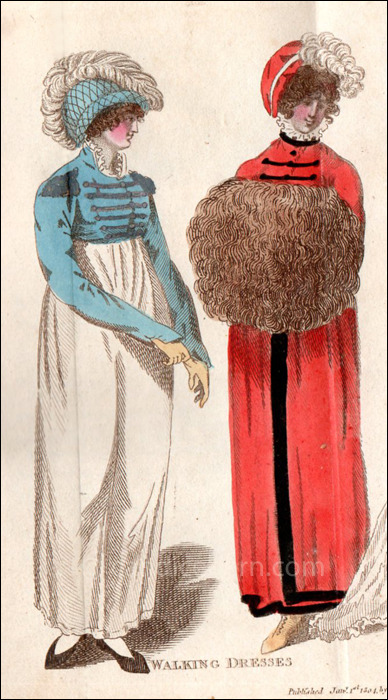
^Lady’s Monthly Museum
January 1804
“Walking Dresses”
This is only half of a larger fold-out print that included two other dresses – a morning dress and an evening dress. (You can see the line of the fold in the figure on the right.) The two walking dresses are described as follows:
“1. A light Blue Beaver Military Helmet Hat, covered with light Blue Netting, ornamented with a White Feather. A short Walking Dress of White Muslin. A Military Spencer, trimmed with Silver Cord, and Epaulette. York tan gloves.
“2. A Scarlet Velvet Bonnet, with a White Ostrich Feather. A Pelisse of Scarlet Kersimere, trimmed with Black Velvet. Brown Bear Muff.”
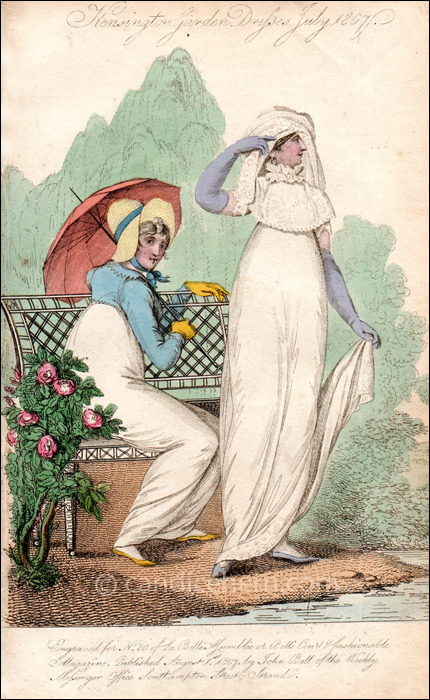
^La Belle Assemblée
July 1807
“Kensington Garden Dresses for July 1807”
The print is described in the magazine as follows:
“No. 1 – A plain cambric round dress, a walking length. Roman spencer of celestial blue sarsnet, with Vandyke lapels and falling collar; finished with the same round the bottom of the waist, and flowing open in front of the bosom. A village hat of Imperial chip, with bee-hive crown, confined under the chin with ribbon the colour of the spencer. Cropped hair, divided in the center of the forehead with full curls. Gloves and shoes of lemon-coloured kid. Parasol of salmon-coloured sarsnet.
“No. 2 – Round train dress of India muslin, with short sleeves, ornamented round the bottom and sleeves with a rich border of needlework. Promenade tippet of Brussels lace, lined with white satin. Hat of white chip, or fancy cap of lilac satin, with a Brussels lace veil. Hair confined in braids over the right temple, and formed in loose curls on the opposite side. Gold hoop earrings. Gloves and slippers of lilac kid.”

^ La Belle Assemblée
March 1810
“Hyde Park Walking Dress”
“A pelisse of black merino cloth or velvet, buttoned from the throat to the feet, made to fit tight to the shape with a band of crape, ornamented with a double row of gold braiding, or an oriental embossed silk trimming, worn over a chemisette of French lawn. A Spanish hat and flat drooping ostrich feather tipped with orange. Half boots of black or orange coloured Morocco; Angola muff lined with yellow [painted pink in this print]; the hair lightly curled on the left side with a thick braid crossing the face. Ear-rings of gold or amber. Gloves of York tan.”
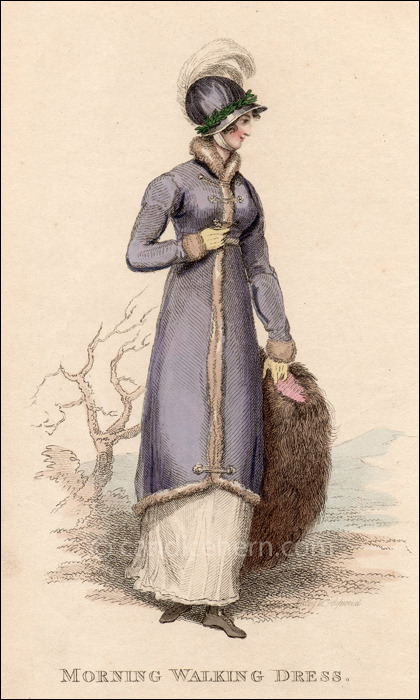
^La Belle Assemblée
November 1812
“Morning Walking Dress”
The print is described in the magazine as follows:
“Short pelisse of deep lilac, shot with white; back broader than they were worn last month, and on each hip a Spanish button. It is made with a collar up to the throat, and trimmed round with rich fur; sleeves long and loose, with a fur at bottom to form a cuff, rather shorter in front than behind, and two Spanish buttons are placed just at the bottom of the pelisse in front, which fastens with a loop crossing from one to the other. The bosom is ornamented in the same manner; a belt of embroidered ribband round the waist, and a gold clasp in front. A bonnet of the same materials as the pelisse, crown a helmet shape, front very small, and a wreath of laurel round it; three white feathers are placed at the back of the bonnet, and fall over the front; broad ribband, same as the bonnet, is pinned plain under the chin. The hair is brought very low at the sides, and a single curl on the forehead. Buff gloves, and dark brown kid boots. Large silver bear muff.”

^Ackermann’s Repository of Arts
November 1814
“Walking Dress”
The print is described in the magazine a follows:
“An Italian striped sarsnet lilac-coloured dress, ornamented round the bottom with a double quilling of satin ribband; short full sleeve, trimmed to correspond; the fronts of the dress cross the bosom and form an open stomacher; a Vandyke French ruff, and full bordered cap to correspond. The satin straw hat, tied under the chin with a check or striped Barcelona handkerchief, crossing the crown with a small plume of ostrich feathers in front. French shawl, a white twill, embroidered with shaded scarlet and green silks, and fancifully disposed on the figure. Gloves, Limerick or York tan, drawn over the elbow. Half-boots of York tan or pale buff kid.”
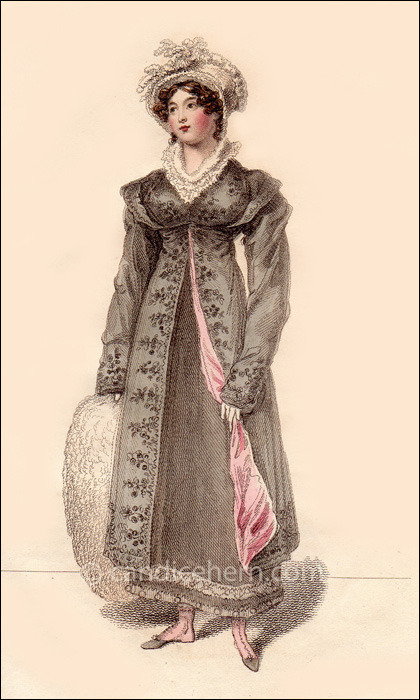
^ La Belle Assemblée
January 1815
“Morning Walking Dress
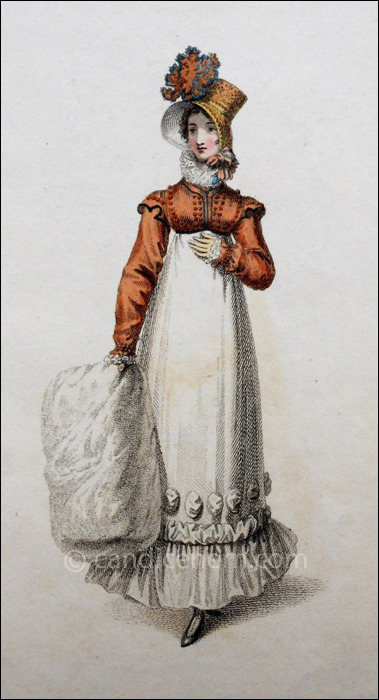
^Ackermann’s Repository of Arts
November 1817
“Walking Dress”
The print is described in the magazine as follows:
“Cambric muslin high dress, the lower part of the body made full, and the upper part, which is tight to the bust, composed entirely of rich work. A row of pointed work forms a narrow pelerine, which is brought rather high on the bosom, and ends in a point in front. The bottom of the skirt is finished by a deep flounce and heading, composed of the same material, which is surmounted by a row of soft muslin bouffone let in at small distances from each other. Over this dress is worn a spencer, composed of gros de Naples, ornamented with figured buttons, which are intermixed with a light, novel, and elegant trimming. For the form of the body, we refer our readers to our print. The sleeve, of a moderate width, is finished at the wrist to correspond with the body, by a double row of buttons and trimming intermixed. The epaulette, of a new and singularly pretty form, is edged with trimming, and finished with buttons on the shoulder. Autumnal bonnet, the front rather large, and of a very becoming shape; the crown low: it is tied under the chin by a large bow of ribbon. We are interdicted from describing either the novel and elegant materials of which this bonnet is composed, or the ornament which finishes it in front. Swansdown muff, lilac sandals, and pale lemon-colour kid gloves.“
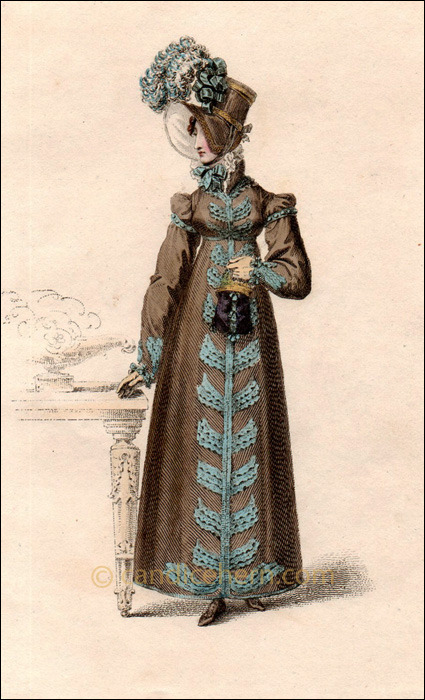
^Ackermann’s Repository of Arts
February 1818
The print is described in the magazine as follows:
“A fawn-coloured poplin round dress: the body is of a three-quarter height; it is cur byas and has no seam, except under the arm. The back is narrower than last month; the fronts just meet, but do not cross; the sleeve is long, rather loose, and confined across the wrist by a satin piping disposed in waves; they are about two inches in length, and are finished by a small silk tuft at the end of each wave. The bust is trimmed to correspond, and the skirt is finished round the bottom by three rows of satin pipings, which form a deep wave, and which are also finished by tufts.“Over this is worn a pelisse composed of fine fawn-coloured cloth, and lined with white sarsnet. The waist of the pelisse is of a moderate length, the body is tight to the shape, and it has a small standing collar. The trimming which goes down the front, and finishes the bottoms of the sleeves, is extremely tasteful; it is an embroidery composed of intermingled blue ribbon and chenille, which ha a very striking effect. The sleeve is rather wide, except at the wrist, and is finished by a half-sleeve in the Parisian style; that is to say, very full on the shoulder, and confined across the arm by a row of small silk buttons. Head-dress, a bonnet composed of satin to correspond with the colour of the pelisse, lined with white sarsnet, and elegantly ornamented with a light embroidery in straw. For the shape of the bonnet, which is singularly becoming, we refer our reader to our print: it is trimmed with blue satin ribbon and a large plume of feathers. Limerick gloves, and half-boots composed of fawn-coloured kid.”
#fashion#regency#regency fashion#walking dress#19th century#19th century fashion#fashion history#resources#gender nonconforming fashion#hats#outerwear
275 notes
·
View notes
Note
ldshadowlady

london bridge has fallen down, my fair lady
[id: a digital drawing of ldshadowlady from last life during her final moments. she's a woman with pink hair, creamy peach skin, pointed ears and rouge eyes. she wears a a white lace pelerine tied into a bow at the front, accompanied by a thin punch-coloured ribbon and pulled over a mauve long-sleeved shirt. her arms flail up in the air; she looks panicked and confused. there's a blue explosion above her forehead that tinges her face and hair slightly blue, and the background is painted dark sky blue. there is a motion blur filter on the edges of the image that makes her seem like she's falling /end id]
#ldshadowlady#mcyt#last life smp#last life fanart#all my art thingx#asks!!#{anony}mous asks: who the fuck are you bestie
34 notes
·
View notes
Text
Matilda, 1830s Mode: Mini-Gown Extravaganza Part 2

Hello again, folks! More Romantic era doll costumes here as promised! There weren’t quite as many as I remembered - I began to branch out into other time periods around this time as I found more patterns, but I got a lot of use out of the Pemberley Threads patterns.
Let’s kick things off with an autumnal scene! (my taking SHAMELESS advantage of the American Girl Samantha Gazebo before my mother sold it on, basically) and strewing plastic pumpkins and fake autumn leaves everywhere. Also present, Felicity’s nightcap masquerading as an 1830s day bonnet.

The brown cotton day dress was my first attempt at the ‘Molly’ pattern, and I made the sleeves a little too tight; it was a strain to get them over the wrists! Plus, the neckline was a little gappy from what I remember. I took a pattern from American Girl Addy’s knitted heartwarmer to make a little tie-around muslin fichu for Matilda to disguise my bad sewing (accessories, folks - don’t underestimjate their power!) and with the scraps left over from her blue nightgown managed to eke out a teeny little doll apron. Matilda looks ready to help with the harvest festival - and I was pretty relieved some of my early mistakes didn’t show...

The little collar here was actual experimentation, as opposed to ‘argh, I made mistakes! HIDE THE EVIDENCE!’
I’ve long really loved the look of the mini capes and pelerines the 1830s are famed for, so I took inspiration from fashion plates like the one below and made a little matching cape in the same dress fabric to set it off. The fancy buckle is a cheap plastic ‘bridal’ buckle you can buy at any craft shop for floral arrangements/wedding decoration. They’re just the right size for a doll sash.///
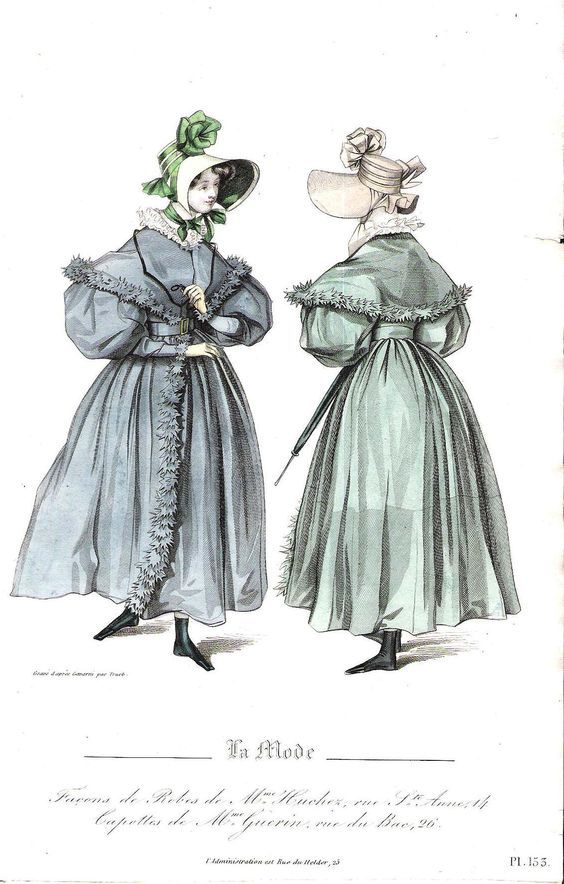
This final 1830s dress is the simplest - but it’s also the one I’m most proud of, because I’d practiced enough with the pattern so I could put it together really well. And I was incredibly lucky with the fabric - it was a fine shot blue/pink cotton by a patchwork/quilting designer called Kaffe Fassett, and it looks beautiful under light - it has this iridescent sheen that just makes it wonderful.
I didn’t bother with trims or lace for this one - I let the fabric speak for itself in its simplicity, and just added a violet sash to pick out the soft pink lurking in the weave. And Matilda photographed so well in it!
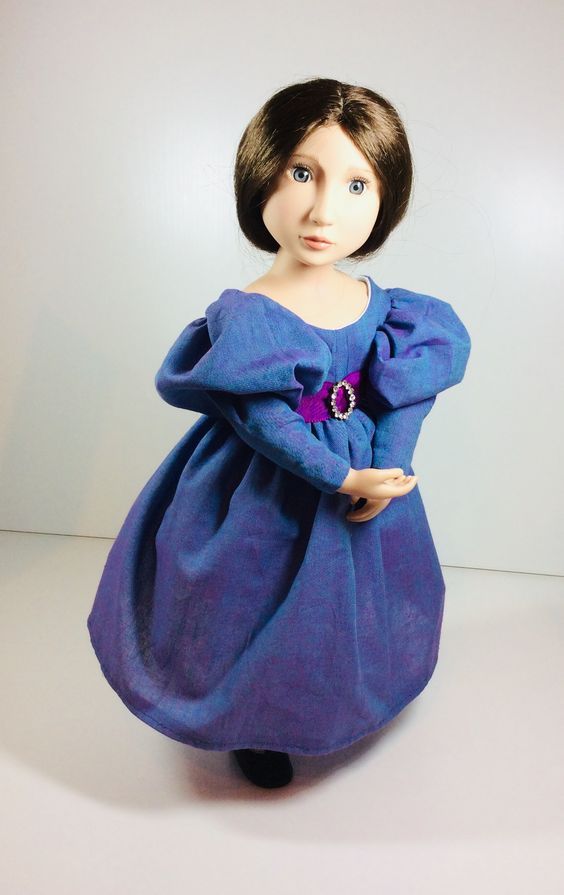
Even in a more subdued light, it’s still a wonderful bluebell colour with a hint of violet/purple in the depths....

#dollblr#agat doll#agat dolls#matilda#1830s fashion#caped dress#doll clothes#doll clothing#doll dressmaking#1830s dresses#romantic era#american girl furniture#modern historical dolls#historical dolls#historical fashion#mini-dressmaking#my sewing#m-p goes all crafty#a girl for all time dolls#a girl for all time
80 notes
·
View notes